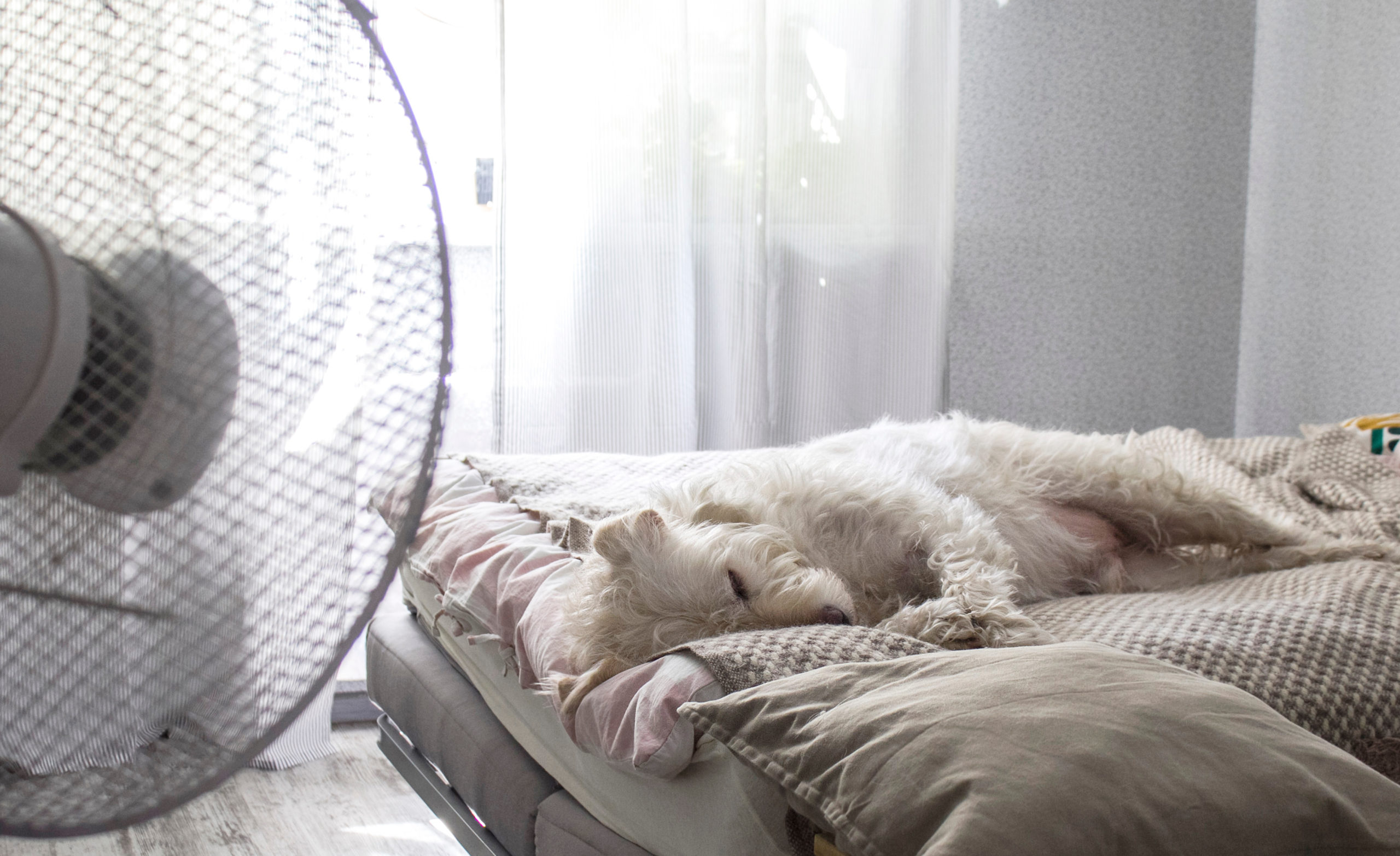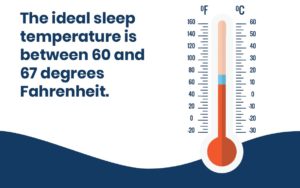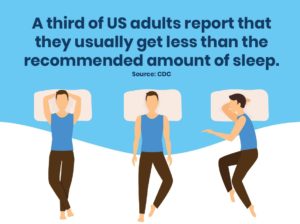Best Temperature for Sleep: What is the Ideal Sleeping Temperature?

The environment we sleep in plays a huge role in how well we sleep each night. If you can remember laying in your bed on a hot summer night, it was likely not a pleasant slumber. That’s because we humans require surroundings to get optimal Zzzs.
Best Temperature for Sleep
Tossing and turning at night can happen for several reasons, but one cause you might not think about is the ambient temperature in your bedroom. Of course, we all know what it feels like to overheat during a summer heatwave or wake up with frozen feet outside the blankets during the winter – but even subtle changes in temperature can negatively or positively affect your sleep quality.
Most sleep experts agree that the best temperature for sleep is between 60- and 67-degrees Fahrenheit, or 15.5 – 19.5 degrees Celsius (Sleep Foundation, 2023). This range supports the body’s natural thermoregulation processes, facilitating the onset and maintenance of restful sleep (Perlmutter, 2025).
- How Does Air Temperature Affect Your Sleep?
- What’s the Best Temperature for Sleep?
- Other Sleeping Tips to Keep Your Room Temperature Cool
How Does Room Temperature Affect Sleep?
What’s the Best Temperature for Sleep?
Your body’s circadian rhythm, a 24-hour internal clock, regulates various physiological processes, including sleep-wake cycles and body temperature. During the day, your core body temperature remains relatively high, promoting alertness. As night approaches, it gradually decreases, reaching its lowest point between 3 a.m. and 6 a.m. (NINDS, 2025).
To facilitate this cooling, blood vessels near the skin surface dilate, allowing heat to dissipate. If your sleeping environment is too warm, it can hinder this heat loss, making it difficult to lower your core body temperature. Conversely, an excessively cold room can cause blood vessels to constrict, retaining heat and potentially leading to discomfort (Perlmutter, 2025).

Maintaining both core and skin temperatures within an optimal range is crucial. Deviations can activate arousal systems, leading to lighter sleep or even awakenings (Perlmutter, 2025).
What’s the Best Room Temperature for Sleeping?
While the recommended sleeping room temperature range is between 60 and 67 degrees Fahrenheit (15.5–19.5°C), individual preferences may vary. It’s essential to find a temperature that feels comfortable for you (Healthline, 2023).
If you share your bed with a partner who prefers a different temperature, consider finding a compromise or investing in products that allow individual temperature control, such as dual-zone mattress pads (Tom’s Guide, 2025).
What’s the Best Temperature for Sleeping By Age?
Although your ideal sleep temperature may shift as you age due to weight and aging changes, the range will still likely fall somewhere in the 60s throughout your life. Women experiencing menopause women might find themselves preferring colder sleep environments, however, to combat heat flashes and other hormonal effects.
Ideal sleep temperatures can vary with age due to physiological changes:
- Children (1–12 years): 65–70°F (18–21°C)
- Adults (18–64 years): 60–67°F (15–19.5°C)
- Seniors (65+ years): 66–70°F (19–21°C)
Women experiencing menopause may prefer cooler environments to alleviate hot flashes and other hormonal symptoms (Sleep Number, 2025).
For infants, it’s crucial to ensure they’re appropriately clothed, as they have difficulty regulating their body temperature and do not use covers due to safety concerns. Overheating can increase the risk of sudden infant death syndrome (SIDS), particularly in colder months (Cleveland Clinic, 2025).
It’s important to be cautious of your baby overheating, which may increase the risk of sudden infant death syndrome (SIDS). This is more prevalent in the winter than the summer. To check the temperature of your baby by touch, touch the back of their neck or stomach as they sleep. If their skin is sweaty or hot to the touch, it’s a good idea to remove a layer of clothing to help them cool off.

Other Sleeping Tips to Keep Your Bedroom Comfortable
1. Invest in Products to Help You Get Your Best Sleep
Beyond controlling the air temperature, various products can enhance your sleep quality. For instance, the Sleep Optimizer ChiliPad is a mattress pad with both cooling and heating capabilities. It circulates water through microtubes to regulate the surface temperature, making it ideal for couples with differing temperature preferences. For example, the Sleep Optimizer ChiliPad is a specially-designed mattress pad that has both cooling and heating capabilities. Designed to regulate the surface temperature of the mattress pad, it actively circulates water through microtubes as you sleep. This is an excellent solution if you sleep with a partner who prefers a slightly warmer or cooler sleeping temperature than you.
Comfortable bedding also plays a significant role. Consider weighted blankets to reduce tossing and turning or silk pillow covers for a luxurious feel. For travelers, portable pillows or sound machines can help maintain a comfortable sleep environment.
2. Keep Your Room Temperature Consistent
Maintaining a stable temperature throughout the night is vital. Set your thermostat to lower during sleep hours. Use air conditioning or heating as needed to keep the room within the ideal range. Ceiling fans can also help circulate air effectively (Health.com, 2023).
If you lack air conditioning, consider these tips (Sleep Foundation, 2023):
- Keep blinds or curtains closed during the day to prevent heat buildup
- Open windows at night if the outside air is cooler
- Sleep on a lower floor, as heat rises
- Stay hydrated by drinking water before bed
- Use an air purifier or fan to circulate air
3. Switch Out Your Bedding Seasonally
In regions with significant temperature variations, adjust your bedding according to the season. A down comforter may be suitable for winter but can be too warm in summer. Opt for lightweight blankets or cooling materials during warmer months. If you’re cold under a comforter, add an extra blanket for insulation (Mattress Clarity, 2025).
4. Keep Your Room Dark
Even with the right temperature, light pollution can disrupt sleep. Eliminate sources of illumination by using blackout shades, sleep masks, or light-blocking stickers on electronic devices (SleepReset, 2025).
5. Create a Sleep-Inducing Routine
Using electronic devices before bed can interfere with melatonin production due to blue light exposure. Consider adding blue light screen protectors or turning off devices at least two hours before bedtime. Instead, engage in activities like reading or meditation (SleepScore, 2025).
Conclusion: Sleep Cool and Comfortable
Experiencing discomfort due to being too hot or cold at night can lead to sleep disruptions and poor sleep quality. Ensuring your bedroom maintains an ideal sleeping temperature is a simple yet effective step toward better sleep. If you’re struggling to fall or stay asleep, checking your thermostat might be the first solution to consider. Implementing these tips can help you sleep better, longer, and wake up feeling refreshed.
How SleepScore Can Help
SleepScore’s technology tracks your sleep environment—including temperature-related disruptions—so you can understand how heat affects your rest. With personalized insights and product recommendations, we help you cool down, sleep deeper, and wake up more refreshed, even on the hottest nights. Download the free app on the Apple and Google Play Store.
Sleep Well!
Sources
- Cleveland Clinic. (2025). What’s the Best Temperature for Sleep?. https://health.clevelandclinic.org/what-is-the-ideal-sleeping-temperature-for-my-bedroom
- Health.com. (2023). 7 Smart Ways to Sleep Better on Hot Nights, According to Experts. https://www.health.com/ways-to-sleep-better-on-hot-nights-11746625
- Healthline. (2023). Scientists Say this is the Ideal Temperature Range for Sleeping. https://www.healthline.com/health-news/scientists-say-this-is-the-best-temperature-for-a-good-nights-sleep
- Mattress Clarity. (2025). What’s the Best Temperature for Sleep? https://www.mattressclarity.com/sleep-resources/ideal-temperature-for-sleep
- National Institute of Neurological Disorders and Stroke. (2025). Understanding Sleep. https://www.ninds.nih.gov/sites/default/files/2025-05/understanding-sleep.pdf
- Perlmutter, A. (2025). The Key Role of Temperature in Sleep Quality. Psychology Today. https://www.psychologytoday.com/us/blog/the-modern-brain/202503/the-key-role-of-temperature-in-sleep-quality
- Sleep Foundation. (2023). How Bedroom Temperatures and Bedding Choices Impact Your Sleep. https://www.sleepfoundation.org/sleep-news/bedroom-temperatures-and-bedding-choices-affect-sleep
- Sleep Number. (2025). Smart Bed Research from Over 9,100 Sleep Sessions Shows How Built-In Temperature Programs Improve Sleep. https://www.businesswire.com/news/home/20250609952904
- SleepReset. (2025). Best Temperature for Sleep: Creating a Comfortable Environment. https://www.thesleepreset.com/blog/best-temperature-for-sleep-creating-a-comfortable-environment
- SleepScore. (2025). Blog. https://www.sleepscore.com/blog
- SweetNight. (2025). Optimal Sleep Temperature: Find Your Best Setting. https://www.sweetnight.com/blogs/news/optimal-sleep-temperature-find-your-best-setting
- Tom’s Guide. (2025). Too Hot to Sleep? 7 Things That Can Make You Overheat at Night. https://www.tomsguide.com/wellness/sleep/too-hot-to-sleep-7-things-that-can-make-you-overheat-at-night
- Wikipedia. (2025). Chilipad. https://en.wikipedia.org/wiki/Chilipad